Blog
Elevating Swollen Feet
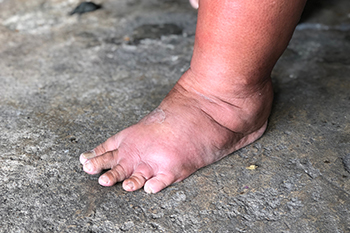
Swelling of the feet is undoubtedly pesky and can make the feet feel puffy, uncomfortable, and inflated. Your feet may swell up for different reasons. For example, foot swelling can be attributed to pregnancy, poor circulation, dietary choices, and many other reasons. If an individual notices that their feet are swollen, they might consider slightly elevating the feet. A person might lie down on their back and elevate their feet and lower legs to a height that is above their heart. This is sometimes particularly easy to perform with a hospital bed because it enables the foot of the bed to rise, which is conducive to elevating the feet. The point of elevating the feet is essential to facilitate blood circulation and encourage blood with fresh oxygen to travel to these elevated limbs. If you struggle with swelling of the feet, you may want to seek out the help of a podiatrist who can help you manage this condition. Schedule an appointment today.
Swollen feet can be a sign of an underlying condition. If you have any concerns, contact Dr. Tupper of Coshocton Foot Health Center. Our doctor can provide the care you need to keep you pain-free and on your feet.
Swollen feet are a common ailment among pregnant women and people who stand or sit for extended periods. Aging may increase the possibility of swollen feet and patients who are obese often notice when their feet are swelling too. There may be medical reasons why swollen feet occur:
- Phlebitis - A condition that causes the veins to become inflamed and can also cause leg pain.
- Liver disease - This may lead to low blood levels of albumin which is a protein. This can cause fluid in the blood to pass into the tissues and several areas of the body can become swollen.
- Heart failure - When the heart doesn’t pump properly the blood that is normally pumped back to the heart can pool in the veins of the legs causing swollen feet.
- Kidney disease - One of the main functions of the kidneys is releasing excess fluid in the body. This type of condition can make it difficult for the kidneys to function properly, and as a result the feet may become swollen.
- Deep-vein thrombosis (DVT)- This is a serious condition where blood clots form in the veins of the legs. They can block the return of blood from the legs to the heart which may cause the feet to swell. It is important to be treated by a podiatrist if this condition is present.
Swollen feet can also be caused by bone and tendon conditions, including fractures, arthritis, and tendinitis. Additionally, there may be skin and toenail conditions and an infection may cause the feet to swell. Patients who take medicine to treat high blood pressure may be prone to getting swollen feet.
Many patients elevate their feet to help relieve the swelling and this is generally a temporary remedy. When a podiatrist is consulted the reason behind the swelling can be uncovered and subsequently treated.
If you have any questions please feel free to contact our office located in Coshocton, OH . We offer the newest diagnostic tools and technology to treat your foot and ankle needs.
Diabetic Foot Wounds Need Prompt Treatment
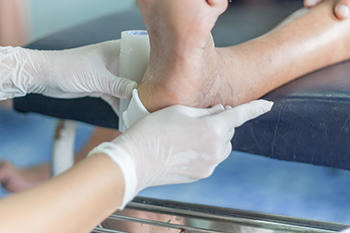
Diabetic patients often develop wounds on their feet, and it may happen as a result of the inability to feel existing cuts, scrapes, or bruises. Neuropathy is a common condition that causes a numbing feeling in the extremities of people who have diabetes. If a cut does not receive prompt treatment, it may develop into a foot ulcer and this is concerning for these types of patients. The initial step in treating this kind of wound involves removing the dead tissue from it, which is referred to as debridement. A podiatrist can expertly perform this task by keeping the blood vessels, nerves, and tendons unscathed while reducing pressure on the wound. Additional benefits of this can include an examination of the remaining healthy tissues, in addition to stimulating healing. If you have diabetes and have developed a foot ulcer, it is strongly advised that you are under the care of a podiatrist who can offer effective relief and treatment options.
Wound care is an important part in dealing with diabetes. If you have diabetes and a foot wound or would like more information about wound care for diabetics, consult with Dr. Tupper from Coshocton Foot Health Center. Our doctor will assess your condition and provide you with quality foot and ankle treatment.
What Is Wound Care?
Wound care is the practice of taking proper care of a wound. This can range from the smallest to the largest of wounds. While everyone can benefit from proper wound care, it is much more important for diabetics. Diabetics often suffer from poor blood circulation which causes wounds to heal much slower than they would in a non-diabetic.
What Is the Importance of Wound Care?
While it may not seem apparent with small ulcers on the foot, for diabetics, any size ulcer can become infected. Diabetics often also suffer from neuropathy, or nerve loss. This means they might not even feel when they have an ulcer on their foot. If the wound becomes severely infected, amputation may be necessary. Therefore, it is of the upmost importance to properly care for any and all foot wounds.
How to Care for Wounds
The best way to care for foot wounds is to prevent them. For diabetics, this means daily inspections of the feet for any signs of abnormalities or ulcers. It is also recommended to see a podiatrist several times a year for a foot inspection. If you do have an ulcer, run the wound under water to clear dirt from the wound; then apply antibiotic ointment to the wound and cover with a bandage. Bandages should be changed daily and keeping pressure off the wound is smart. It is advised to see a podiatrist, who can keep an eye on it.
If you have any questions, please feel free to contact our office located in Coshocton, OH . We offer the newest diagnostic and treatment technologies for all your foot care needs.
Diving and Foot Fractures
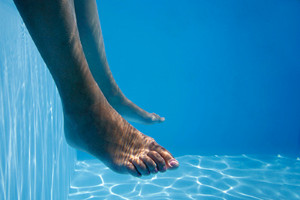
Diving can be safe and fun. However, as with most sports, injuries can occur, and awareness can help with prevention. The most common injury that might affect the feet with diving is smacking the diving board while taking off. Usually, this will result in minor scrapes but can cause a foot fracture. Most diving collisions occur from poor takeoff from the springboard or platform. Things have been invented to help limit these accidents, such as dryland diving equipment which enables one to attempt a dive using a harness over the water or trampoline. The best prevention is continuously practicing the fundamentals of the sport, including board work and takeoffs. Even the best athletes sometimes sustain injuries while participating in sports if you have fractured your foot while diving, see a podiatrist who can provide the best treatment options.
Ankle and foot injuries are common among athletes and in many sports. They can be caused by several problems and may be potentially serious. If you are feeling pain or think you were injured in a sporting event or when exercising, consult with Dr. Tupper from Coshocton Foot Health Center. Our doctor will assess your condition and provide you with quality foot and ankle treatment.
Common Injuries
The most common injuries that occur in sporting activities include:
- Achilles Tendonitis
- Achilles Tendon Rupture
- Ankle Sprains
- Broken Foot
- Plantar Fasciitis
- Stress Fractures
- Turf Toe
Symptoms
Symptoms vary depending upon the injury and in some cases, there may be no symptoms at all. However, in most cases, some form of symptom is experienced. Pain, aching, burning, bruising, tenderness, tightness or stiffness, sensation loss, difficulty moving, and swelling are the most common symptoms.
Treatment
Just as symptoms vary depending upon the injury, so do treatment options. A common treatment method is known as the RICE method. This method involves rest, applying ice, compression and elevating the afflicted foot or ankle. If the injury appears to be more serious, surgery might be required, such as arthroscopic or reconstructive surgery. Lastly, rehabilitation or therapy might be needed to gain full functionality in the afflicted area. Any discomfort experienced by an athlete must be evaluated by a licensed, reputable medical professional.
If you have any questions, please feel free to contact our office located in Coshocton, OH . We offer the newest diagnostic and treatment technologies for all your foot care needs.
Wounds That Don't Heal Need to Be Checked
Foot Care Is Critical for Seniors
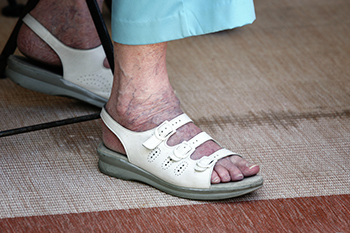
As we age our feet change and things can happen to our feet that affect our overall health and quality of life. Specific foot issues may arise depending on the shoes worn, level of activity, and genetics. With all the wear and tear our feet endure throughout our lifetimes, it’s no wonder there would be stress and strain felt as we age. With aging, our cells hold less water, which in turn can affect collagen, tendons, and ligaments in the feet. Tendons generally get tighter, and ligaments may get looser. With aging, circulation can decline as well as our body’s natural healing ability. Overuse and joint issues are also more common with age. When things in the feet shift, bone spurs can develop, and we can feel pain. To deal with the likely inevitabilities of foot issues, if you are a senior or a caregiver, include a podiatrist in your health care team and schedule regular check-ups.
If you need your feet checked, contact Dr. Tupper of Coshocton Foot Health Center. Our doctor will attend to all of your foot and ankle needs and provide you with quality treatment.
Geriatrics and Podiatry
When people age, some common issues that may occur are bone density loss, dry skin, poor circulation, and rough brittle nails. These issues may also affect your foot health if the necessary steps are not taken to alleviate the problems.
It is important to take care of your feet because feet that are injured or diseased can affect your overall health. Having painful feet hinders your ability to do daily activities or may decrease your willingness to do the things that you need to do.
Visiting Your Geriatrician
As we age, health problems become more likely, so it is essential to visit your doctor for check-ups to ensure that you are doing the best you can to take care of your health. It is recommended to check your feet frequently for any possible cuts, bruises, swelling, corns or any other irregularities.
Taking Care of Elderly Feet
Cracked or dry feet can be treated by applying moisturizer often. It is also important not to wear old socks because the older the sock is, the higher the possibility there will be that there is bacteria there. Wear fresh socks and make sure they fit properly.
Proper foot health means that you can have a more active lifestyle and you will not be bogged down by pain. Foot health also leads to good circulation, which is paramount for overall health.
If you have any questions, please feel free to contact our office located in Coshocton, OH . We offer the newest diagnostic tools and technology to treat your foot and ankle needs.
All About the Arches of the Feet
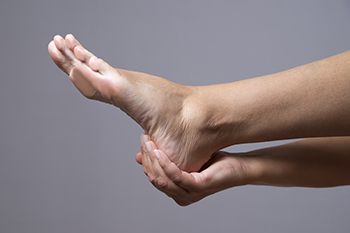
The arches of the feet work as a spring that bears the weight of your body whenever you take a step. Most people are familiar with the arch on the inner sole of the midfoot. However, three separate arches combine to form a triangle in the feet that absorb the shock of walking and running. There are two longitudinal arches, medial and lateral, that run along either side of the foot from the heel to the top of the 1st and 5th metatarsal. Plus there is a transverse arch that runs across the midfoot, connecting the tops of the metatarsals. These three arches are supported by a number of ligaments, muscles, tendons, and bones that all help to support the weight of the body. When the medial longitudinal arch is too high, it causes a condition called pes cavus, which can be painful and cause gait problems. When the longitudinal arches collapse, it results in flat feet, known as pes planus. Both conditions, which can affect the way you carry out your daily activities, can be diagnosed and treated by a podiatrist.
If you have any concerns about your feet, contact Dr. Tupper from Coshocton Foot Health Center. Our doctor can provide the care you need to keep you pain-free and on your feet.
Biomechanics in Podiatry
Podiatric biomechanics is a particular sector of specialty podiatry with licensed practitioners who are trained to diagnose and treat conditions affecting the foot, ankle and lower leg. Biomechanics deals with the forces that act against the body, causing an interference with the biological structures. It focuses on the movement of the ankle, the foot and the forces that interact with them.
A History of Biomechanics
- Biomechanics dates back to the BC era in Egypt where evidence of professional foot care has been recorded.
- In 1974, biomechanics gained a higher profile from the studies of Merton Root, who claimed that by changing or controlling the forces between the ankle and the foot, corrections or conditions could be implemented to gain strength and coordination in the area.
Modern technological improvements are based on past theories and therapeutic processes that provide a better understanding of podiatric concepts for biomechanics. Computers can provide accurate information about the forces and patterns of the feet and lower legs.
Understanding biomechanics of the feet can help improve and eliminate pain, stopping further stress to the foot.
If you have any questions please feel free to contact our office located in Coshocton, OH . We offer the newest diagnostic and treatment technologies for all your foot and ankle needs.
Your Feet Get You Places
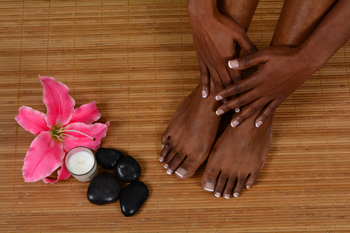
Given how much work our feet do for us in getting places in life, it stands to reason that we should take care of them well. Feet that look good generally feel good. Going barefoot can lead to injuries, especially if done so on hard surfaces. It is better to wear cushioned sandals or slippers when indoors. Choosing the right footwear is imperative in taking care of your feet. It is important to wear supportive shoes designed for the activity undertaken. One would not want to wear tennis shoes for running or high heels for working or standing for prolonged periods. When shoe shopping, cushioning, arch support, and shock absorption are key factors to look for. The shape of the shoe should also match the shape of the foot, and shoes should be comfortable from the moment they are tried on. Assess the soles of the shoes to examine unevenness as well as wear and tear, and replace shoes when necessary. Check your feet regularly and gift yourself pedicures and foot massages as key ways to relax the feet and care for them. If you have problems with your feet, do not self-diagnose. Instead, visit a podiatrist who can examine your feet and catch and treat anything that goes amiss.
Everyday foot care is very important to prevent infection and other foot ailments. If you need your feet checked, contact Dr. Tupper from Coshocton Foot Health Center. Our doctor can provide the care you need to keep you pain-free and on your feet.
Everyday Foot Care
Often, people take care of their bodies, face and hair more so than they do for their feet. But the feet are a very important aspect of our bodies, and one that we should pay more attention to. Without our feet, we would not be able to perform most daily tasks.
It is best to check your feet regularly to make sure there are no new bruises or cuts that you may not have noticed before. For dry feet, moisturizer can easily be a remedy and can be applied as often as necessary to the affected areas. Wearing shoes that fit well can also help you maintain good foot health, as well as making it easier to walk and do daily activities without the stress or pain of ill-fitting shoes, high heels, or even flip flops. Wearing clean socks with closed shoes is important to ensure that sweat and bacteria do not accumulate within the shoe. Clean socks help to prevent Athlete’s foot, fungi problems, bad odors, and can absorb sweat.
If you have any questions please feel free to contact our office located in Coshocton, OH . We offer the newest diagnostic and treatment technologies for all your foot and ankle needs.
Reasons for Swollen Feet During Pregnancy
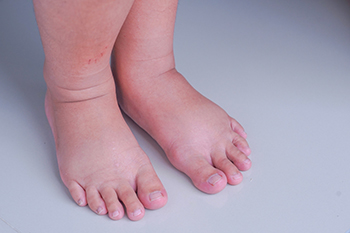
One of the most common things pregnant women experience is swollen feet and ankles. The body produces 50% more fluids and blood, and this is needed to soften the body as the baby develops. Additionally, it helps the pelvic area to prepare for delivery, and these extra fluids are responsible for approximately 25% of weight gain during pregnancy. There are outside factors that may contribute to sudden weight gain and can be controlled to limit extra weight gain from fluids. These can include standing for extended periods of time, eating foods that have increased levels of sodium, and choosing to eat foods that are low in potassium. Swollen feet may be helped by wearing supportive stockings, frequently elevating the feet, and drinking plenty of water daily. For more tips on how to reduce swollen ankles, please confer with a podiatrist who can help you with effective prevention methods.
Pregnant women with swollen feet can be treated with a variety of different methods that are readily available. For more information about other cures for swollen feet during pregnancy, consult with Dr. Tupper from Coshocton Foot Health Center. Our doctor will attend to all of your foot and ankle needs.
What Foot Problems Can Arise During Pregnancy?
One problem that can occur is overpronation, which occurs when the arch of the foot flattens and tends to roll inward. This can cause pain and discomfort in your heels while you’re walking or even just standing up, trying to support your baby.
Another problem is edema, or swelling in the extremities. This often affects the feet during pregnancy but tends to occur in the later stages.
How Can I Keep My Feet Healthy During Pregnancy?
- Wearing orthotics can provide extra support for the feet and help distribute weight evenly
- Minimize the amount of time spent walking barefoot
- Wear shoes with good arch support
- Wear shoes that allow for good circulation to the feet
- Elevate feet if you experience swelling
- Massage your feet
- Get regular, light exercise, such as walking, to promote blood circulation to the feet
If you have any questions please feel free to contact our office located in Coshocton, OH . We offer the newest diagnostic and treatment technologies for all your foot and ankle needs.
It's Time for Beautiful Feet
Proper Treatment of Broken Toes

The toes contain many of 26 bones in the foot. Fractures of these bones are common and must be treated properly. Traumatic fractures are caused by a direct impact, such as dropping something heavy on the toe. These fractures can cause the bones to be displaced, giving the bone a crooked or abnormal appearance. Stress fractures are tiny hairline cracks along the length of the bone, mostly the result of repetitive use. Runners often have stress fractures. Experts agree that both types of fractures need medical treatment so they heal properly. If ignored, or allowed to heal on its own, a toe fracture can limit mobility or make it difficult to find shoes that fit. Other consequences include an onset of arthritis, chronic pain, and deformity. Treatment of broken toes should be overseen by a podiatrist who can examine the toe and diagnose the severity of the injury. In many cases non-surgical treatment, such as buddy wrapping, is sufficient. But with certain types of fractures, surgery may be required. If you have broken or even severely bruised a toe, please consult a podiatrist as soon as possible.
Broken toes may cause a lot of pain and should be treated as soon as possible. If you have any concerns about your feet, contact Dr. Tupper from Coshocton Foot Health Center. Our doctor will treat your foot and ankle needs.
What Is a Broken Toe?
A broken toe occurs when one or more of the toe bones of the foot are broken after an injury. Injuries such as stubbing your toe or dropping a heavy object on it may cause a toe fracture.
Symptoms of a Broken Toe
- Swelling
- Pain (with/without wearing shoes)
- Stiffness
- Nail Injury
Although the injured toe should be monitored daily, it is especially important to have a podiatrist look at your toe if you have severe symptoms. Some of these symptoms include worsening or new pain that is not relieved with medication, sores, redness, or open wounds near the toe.
If you have any questions, please feel free to contact our office located in Coshocton, OH . We offer the newest diagnostic and treatment technologies for all your foot care needs.
More...
Blisters on the Bottom of the Feet
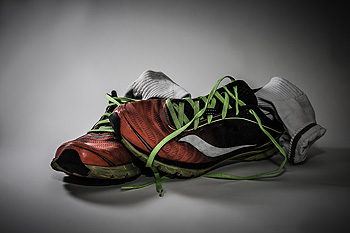
Blisters that form on the bottom of the feet can take the joy out of running, exercising, and participating in sporting activities. Blisters are common among athletes. So many seek to know their cause and how to care for them. A blister typically forms due to excessive friction from wearing shoes and socks that do not fit correctly. A bubble filled with liquid will form and remain that way until the raw skin underneath it has healed. Blisters on the bottom of the foot may heal faster when a gauze bandage is applied. The bandage can also provide the protection needed to avoid premature popping. Elevating the foot at the end of the day may be beneficial, as well as removing the bandage to allow air to reach the blister. Soaking the feet in warm water may help keep the blister clean, which can help to prevent an infection from developing. Blisters on the bottom of the feet can be bothersome, so if you are afflicted with one or more, please consult a podiatrist who can guide you toward the correct treatment.
Blisters are prone to making everyday activities extremely uncomfortable. If your feet are hurting, contact Dr. Tupper of Coshocton Foot Health Center. Our doctor can provide the care you need to keep you pain-free and on your feet.
Foot Blisters
Foot blisters develop as a result of constantly wearing tight or ill-fitting footwear. This happens due to the constant rubbing from the shoe, which can often lead to pain.
What Are Foot Blisters?
A foot blister is a small fluid-filled pocket that forms on the upper-most layer of the skin. Blisters are filled with clear fluid and can lead to blood drainage or pus if the area becomes infected.
How Do Blisters Form?
Blisters on the feet are often the result of constant friction of skin and material, usually by shoe rubbing. Walking in sandals, boots, or shoes that don’t fit properly for long periods of time can result in a blister. Having consistent foot moisture and humidity can easily lead to blister formation.
Prevention & Treatment
It is important to properly care for the affected area in order to prevent infection and ease the pain. Do not lance the blister and use a Band-Aid to provide pain relief. Also, be sure to keep your feet dry and wear proper fitting shoes. If you see blood or pus in a blister, seek assistance from a podiatrist.
If you have any questions, please feel free to contact our office located in Coshocton, OH . We offer the newest diagnostic and treatment technologies for all your foot care needs.
Common Foot Problems of Children
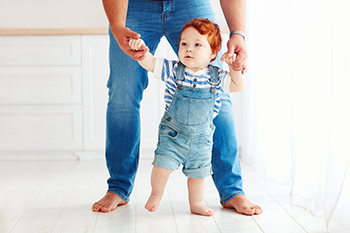
As babies grow and begin to walk, their gait may at first seem awkward while developing strength and learning to maintain their balance. By about 18 months, parents may wish to watch their child’s gait and notice any problems that may need attention. Common foot problems in children are bow legs, knock knees, and flat feet. Other potential foot problems include in-toeing, out-toeing, and tiptoe walking. Many of these tendencies are normal in toddlers and often self-correct between the ages of 6 and 8 years old. One of the best ways to keep your child’s foot development on track is by providing proper footwear. It is essential that shoes and socks are the correct sizes. A child’s foot grows rapidly, which may mean replacing shoes and socks often. For more information on the common foot problems of children, it is suggested that you consult with a podiatrist.
The health of a child’s feet is vital to their overall well-being. If you have any questions regarding foot health, contact Dr. Tupper of Coshocton Foot Health Center. Our doctor can provide the care you need to keep you pain-free and on your feet.
Tips for Keeping Children's Feet Healthy
- Make sure their shoes fit properly
- Look for any signs of in-toeing or out-toeing
- Check to see if they have Clubfoot (condition that affects your child’s foot and ankle, twisting the heel and toes inward) which is one of the most common nonmajor birth defects.
- Lightly cover your baby’s feet (Tight covers may keep your baby from moving their feet freely, and could prevent normal development)
- Allow your toddler to go shoeless (Shoes can be restricting for a young child’s foot)
- Cut toenails straight across to avoid ingrown toenails
- Keep your child’s foot clean and dry
- Cover cuts and scrapes. Wash any scratches with soap and water and cover them with a bandage until they’ve healed.
If you have any questions, please feel free to contact our office located in Coshocton, OH . We offer the newest diagnostic and treatment technologies for all your foot care needs.
What Causes Chronic Ankle Instability?
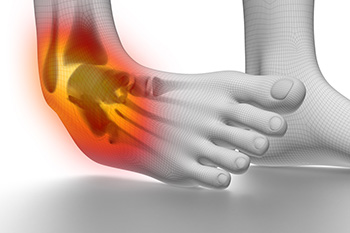
When you are walking along and suddenly your ankle gives way, causing the foot to roll over onto its side, you may have chronic ankle instability. Common complaints of ankle instability include repeated turning of the ankle, frequent swelling, pain, and tenderness. The main cause connected to chronic instability is repeated ankle sprains. Often the reason for this is not allowing the ankle to heal completely after a sprain. This healing process can take months, and impatience to get back to the activity may put the ankle at risk for another sprain. The ligaments may become overstretched, increasing the instability of the joint and putting other parts of the foot at risk for injury. Seeking the help of a podiatrist is essential in dealing with ankle instability when it reaches the chronic level. Both nonsurgical and surgical options may be needed. After a thorough examination and diagnosis, a podiatrist can determine the best treatment options for you.
Ankle sprains are common but need immediate attention. If you need your feet checked, contact Dr. Tupper from Coshocton Foot Health Center. Our doctor can provide the care you need to keep you pain-free and on your feet.
How Does an Ankle Sprain Occur?
Ankle sprains take place when the ligaments in your ankle are torn or stretched beyond their limits. There are multiple ways that the ankle can become injured, including twisting or rolling over onto your ankle, putting undue stress on it, or causing trauma to the ankle itself.
What Are the Symptoms?
- Mild to moderate bruising
- Limited mobility
- Swelling
- Discoloration of the skin (depending on severity)
Preventing a Sprain
- Wearing appropriate shoes for the occasion
- Stretching before exercises and sports
- Knowing your limits
Treatment of a Sprain
Treatment of a sprain depends on the severity. Many times, people are told to rest and remain off their feet completely, while others are given an air cast. If the sprain is very severe, surgery may be required.
If you have suffered an ankle sprain previously, you may want to consider additional support such as a brace and regular exercises to strengthen the ankle.
If you have any questions please feel free to contact our office located in Coshocton, OH . We offer the newest diagnostic and treatment technologies for all your foot and ankle needs.
Methods That Can Help Feet as They Age

Research has indicated the number of foot conditions can increase as the aging process occurs. The feet may gradually lose cushioning, and the nails to become dry and brittle. Additionally, existing foot wounds may take longer to heal as a result of reduced blood circulation. The feet will generally feel better when the shoes that are worn are comfortable and are the correct size in both length and width. Some elderly people do not take the time to get fitted for shoes, and may continue to wear shoes they have outgrown. This can lead to possibly developing unpleasant foot conditions that may consist of bunions, ingrown toenails, corns, and calluses. Many elderly people may spend the majority of the day sitting in a chair and can develop poor circulation. This may be avoided by performing gentle exercises and stretches and incorporating walking into the daily routine. There are simple methods to care for feet as they age, and if you would like to know more about how to implement these, please confer with a podiatrist.
Proper foot care is something many older adults forget to consider. If you have any concerns about your feet and ankles, contact Dr. Tupper from Coshocton Foot Health Center. Our doctor can provide the care you need to keep you pain-free and on your feet.
The Elderly and Their Feet
As we age we start to notice many changes in our body, but the elder population may not notice them right away. Medical conditions may prevent the elderly to take notice of their foot health right away. Poor vision is a lead contributor to not taking action for the elderly.
Common Conditions
- Neuropathy – can reduce feeling in the feet and can hide many life-threatening medical conditions.
- Reduced flexibility – prevents the ability of proper toenail trimming, and foot cleaning. If left untreated, it may lead to further medical issues.
- Foot sores – amongst the older population can be serious before they are discovered. Some of the problematic conditions they may face are:
- Gouging toenails affecting nearby toe
- Shoes that don’t fit properly
- Pressure sores
- Loss of circulation in legs & feet
- Edema & swelling of feet and ankles
Susceptible Infections
Diabetes and poor circulation can cause general loss of sensitivity over the years, turning a simple cut into a serious issue.
If you have any questions please feel free to contact our office located in Coshocton, OH . We offer the newest diagnostic and treatment technologies for all your foot and ankle needs.


